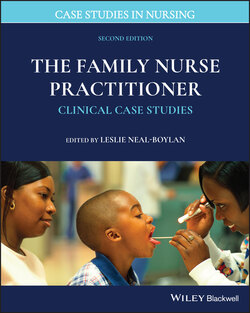Читать книгу The Family Nurse Practitioner - Группа авторов - Страница 18
ОглавлениеCase 1.5 Nutrition and Weight
By Mikki Meadows‐Oliver, PhD, RN, FAAN
SUBJECTIVE
Anita is a 2‐week‐old Hispanic female in for her well‐child check. She is accompanied by her 15‐year‐old mother. The family speaks only Spanish. A Spanish‐speaking interpreter is used for the visit. Anita’s mother is concerned that Anita spits up a lot after eating. The mother states that the vomit is not projectile. The mother is worried that, since the baby is vomiting so much, she is not getting enough food. Therefore, the mother has been feeding Anita even more formula. Also, Anita’s mother is worried that she will run out of formula since the baby takes so much.
Diet: Formula feeding: 5 oz every 2–3 hours.
Elimination: 6 wet diapers and 3 bowel movements since yesterday.
Sleep: Sleeps approximately 4 hours at night with several naps throughout the day.
Medications: Currently taking no prescription, herbal, or over‐the‐counter medications.
Allergies: No known allergies to food, medications, environment.
Birth history: Anita was the product of a 38‐week gestation. She was delivered via spontaneous vaginal delivery. Anita’s mother had no falls, infections, or known exposures to environmental hazards. The only prescription medications taken during the pregnancy were prenatal vitamins. She did not use alcohol, tobacco products, or illicit drugs during the pregnancy. Anita’s birth weight was 3250 g and her Apgar scores were 8 at 1 minute and 9 at 5 minutes. Her discharge weight was 3180 g.
Social history: Anita lives at home with her teenage mother and her maternal grandmother (MGM), who emigrated from Mexico. The father of the baby is involved. Neither parent has any other children. Both parents are students at a local high school. The family has a dog.
Family medical history: PGF (age 37): high blood pressure; PGM (age 33): thyroid problems; MGF (age 35): health history unknown; MGM (age 30): healthy; mother (age 15): healthy; father (age 15): healthy.
OBJECTIVE
Vital signs: Weight: 4050 g; length: 48 cm; temperature: 37.3°C (rectal).
General: Alert, well‐developed baby.
Skin: Clear with no lesions noted; no cyanosis of skin, lips, or nails; no diaphoresis noted; good skin turgor.
Head: Normocephalic; anterior fontanel is open and flat (3 cm × 2 cm); posterior fontanel is open and flat (1.0 cm × 0.5 cm).
Eyes: Red reflex present bilaterally; pupils equal, round, and reactive to light; no discharge noted.
Ears: Pinnae normal; tympanic membranes gray bilaterally with positive light reflex.
Nose: Both nostrils congested; cloudy discharge present in nares; mild nasal flaring.
Oropharynx: Mucous membranes moist; no teeth present; no lesions.
Neck: Supple; no nodes.
Respiratory: RR = 24; lungs with clear breath sounds in all lobes; no retractions present; no grunting; no deformities of the thoracic cage noted.
Cardiac/Peripheral vascular: HR = 120; regular rhythm; no murmur noted; brachial and femoral pulses present and 2+ bilaterally.
Abdomen/Gastrointestinal: Soft, nontender, nondistended, no evidence of hepatosplenomegaly.
Genitourinary: Normal female genitalia.
Back: Spine straight.
Extremities: Full range of motion of all extremities; warm and well‐perfused; capillary refill <2 seconds; negative hip click.
Neurologic: Good suck and cry; good tone in all extremities; positive Moro, rooting, plantar, palmar, and Babinski reflexes.
CRITICAL THINKING
1 Which diagnostic or imaging studies should be considered to assist with or confirm the diagnosis?___Upper gastrointestinal (GI) imaging series___Manometry to assess esophageal motility and lower esophageal sphincter function___Complete blood count
2 What is the most likely differential diagnosis and why?___Overfeeding___Gastroesophageal reflux disease___Gastroenteritis
3 What is the plan of treatment and follow‐up care?
4 Does the patient’s psychosocial history impact how you might treat this case?
5 What demographic characteristics might affect this case?
6 Are there any standardized guidelines that should be used to assess or treat this case?
